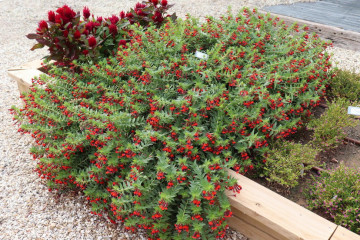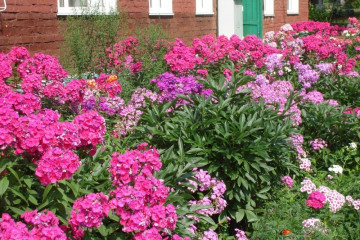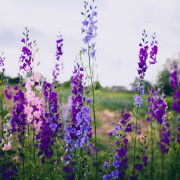Annual phlox: planting and care
Content:
There is a belief that if one-year-old yellow Drummond phlox is planted in a flower bed in front of the entrance to the house or in a box on the balcony, then material well-being will come to the family. There is only one way to confirm or deny the magical qualities of phloxes - to grow these flowers. In any case, they will become a wonderful decoration for your yard or apartment.
Annual phlox flower - description
The vast majority of phloxes belong to perennial herbaceous plants, the tops of which are decorated with small flowers, collected in corymbose bunches. By the cold weather, perennial phloxes die off aboveground stems, and the roots overwinter in open ground, sprinkled with leaves and snow. In spring, new shoots sprout from the roots of perennials.
One-year-old phlox needs to be re-grown every year. This is done through seedlings or by sowing seeds directly into the ground. Phlox seedlings develop into branchy, lush low-growing shrubs with colorful dense inflorescences.
The size of phlox and the intensity of their color depend on the growing conditions - varieties of mini phlox with abundant watering and feeding, sufficient lighting can grow up to 1.0 m and be very bright, under normal conditions these phlox will not become higher than 30 cm.
Reproduction of annuals
Annual phloxes are propagated by seeds. It was once believed that planting and caring for one-year-old phlox is a very difficult task that does not always end successfully. Not everyone was able to see how phlox sprout.
But then they drew attention to the fact that sometimes self-sown seedlings appear in the spring, the seeds of which fell to the surface of the soil in the fall and no one sprinkled them with earth. And if the rain and melted snow did not wash these seeds into the holes, they germinated successfully.
Phloxes are propagated in two ways. In southern regions and areas of mild temperate climates, seeds are sown directly on the soil surface. In areas with severe winters, in the mountainous regions of the Urals, Siberia, seedlings are first grown. Annual phlox plants grown from freshly harvested seeds will be disease and pest resistant.
Necessary conditions for growing seeds
In order to successfully grow annual phlox, you need to follow several rules:
- for sowing, only large seeds are selected from fully ripe seed pods;
- to obtain large seeds on mother plants, several stems with inflorescences and stepsons are removed, half of the buds are left in the inflorescences;
- healthy, well-developed bushes are used as a mother plant, they are intensively fed and watered.
For the formation of a spherical bush and the formation of numerous lateral shoots, phloxes begin to pinch even at the seedling stage. After the appearance of 5 leaves, the top of the central stem is either cut off or pinched by hand.
Seed preparation for sowing
Dried boxes with Drummond phlox seeds are stored in a cold place - basement, vegetable compartment of the refrigerator. The seeds are not removed from the pods until they are sown. This is due to the fact that the seeds dry out quickly in the air and lose their germination.
A few days before sowing, the seeds are poured from the testes and soaked in a pink solution of potassium permanganate for 10-15 minutes. The floating seeds are thrown away, the rest are washed in running water. Then they are dried, spread on a paper towel, and planted in a nursery.
How to sow seeds for seedlings
Phlox seeds sprout for a long time - up to 3-4 weeks. Therefore, seeds are sown for seedlings in early to mid-March. Seating boxes must have sides with a height of at least 5 cm and drainage holes. The moistened soil substrate is poured 3/4 of the height of the box. The surface of the soil is tamped with the back of a tablespoon or scoop.
Seeds are spread with a damp toothpick over the surface of the soil in rows at intervals of 3-5 cm and lightly sprinkled with a thin layer of sand. Sowing can be messy - for this, the seeds are mixed with sand and scattered over the box as it happens.
In the boxes, they create the conditions for a mini-greenhouse: they are covered with glass or transparent plastic. Check periodically for signs of mold and pests, ventilate and moisturize.
What does phlox seedlings look like
After the seeds hatch, it will take at least 2-3 weeks for 2 pairs of true leaves to grow.
At this time, the plants dive - they are transplanted into more spacious boxes, they maintain a distance of 8-10 cm between the bushes.
After three months, the plants will already have 5-6 pairs of leaves and the first buds.
Seedling care rules
The containers in which the seeds are sown are kept at room temperature no higher than + 25 ° C. After the seedlings appear, the boxes with them should be exposed to the light for at least 12 hours a day.
If the seedlings begin to stretch, then the ambient temperature is reduced to + 15 + 18 ° C and the daylight hours are extended to 14-15 hours. Use lamps for artificial supplementary lighting of seedlings.
The soil in the seed boxes is kept constantly moist. Do not allow abundant watering, otherwise the roots may rot. Before planting in a flower garden, plants are fed with nitroammophos or other complex preparations.
Unlike plants that grow from seeds immediately in a flower garden, the tips of the root shoots suffer from seedlings even with the most careful handling. Therefore, it is during this period that the transplanted plants require timely watering.
Annual phlox: care features
- Choosing a place for planting, soil
Perennials and annuals require the same growing conditions - a nutritious loose soil with neutral acidity, a moderate occurrence of soil water, a plot of land well protected from the wind, a lot of light.
- Flower care during and after flowering
A well-established flower grows a stem and increases the number of leaves, produces many inflorescences that form a dense bunch. Plants need good nutrition, which comes through the roots along with moisture.
Watering is carried out as the soil dries up. Do not allow the formation of a surface soil crust - carry out regular, gentle loosening.
They make sure that there are no weeds in the root zone and next to the plants, they constantly cut off withered, dried flowers along with the stems.
- Preparing for winter
How to feed phlox for abundant flowering
For the entire flowering period, it is necessary to carry out 3 nitrogen mineral dressings, alternating with organic fertilizers - water extracts of ash, chicken droppings containing potassium and calcium, herbal infusion.
The first nitrogen fertilization is carried out before planting the seedlings in the flower garden. Then the condition of the plants is monitored. Signs of a lack of nutrition will be yellowing of the leaves, inhibition of stem growth, and a decrease in the size of flowers.
Why perennial phlox do not bloom
Perennial or annual phloxes will not be able to bloom if they grow in dense shade.
Their stems will become thinner and elongated. The plant will give all its strength to get to the sun, because without it the processes of photosynthesis will not take place, and there will be no strength left for flowering.
In addition, planting and caring for annual and perennial phloxes should ensure that the plants do not suffer from a lack or excess of moisture and nutrients, do not get sick and are not attacked by pests.
What to plant next to phlox
Drummond's various varieties complement each other well.
For example, the colorful colors of the Star Rain variety make it possible to compose compositions only from plants of this species.
But nevertheless, if you plant chrysanthemums, delphiniums, aquilegia and Drummond terry phloxes next to it, then the flower garden will become an adornment of any personal plot or flower bed in the park area.
Pests and diseases - how to deal with them
Modern experienced gardeners know that various herbal decoctions and folk remedies can scare off pests and slow down the development of diseases. But only professional methods based on chemical and biological preparations will help to destroy insects and cure diseases.
- Snails and slugs. Timely loosen the soil, sprinkle the paths near the phlox with ash, collect by hand and destroy.
- Nematodes. Qualitative protection measures have not been invented - it is better to pull out the affected plants and destroy, preventing the spread of the pest.
- Scoops. Collect tracks by hand. In case of severe damage, use insecticides.
- The penny is slobbering. Remove damaged leaves, process with garlic infusion.
- Green wood bug. Spray phlox with onion infusion.
- Cruciferous fleas. Dust the phlox with wood ash in the morning.
Control measures depend on the specific disease or pest.
Growing annual flowers requires additional time spent sowing seeds and planting seedlings. But even if the gardener has to break away from household chores, in order to plant and care for plants throughout the summer season, he will do it without hesitation. After all, beauty is worth it.






















